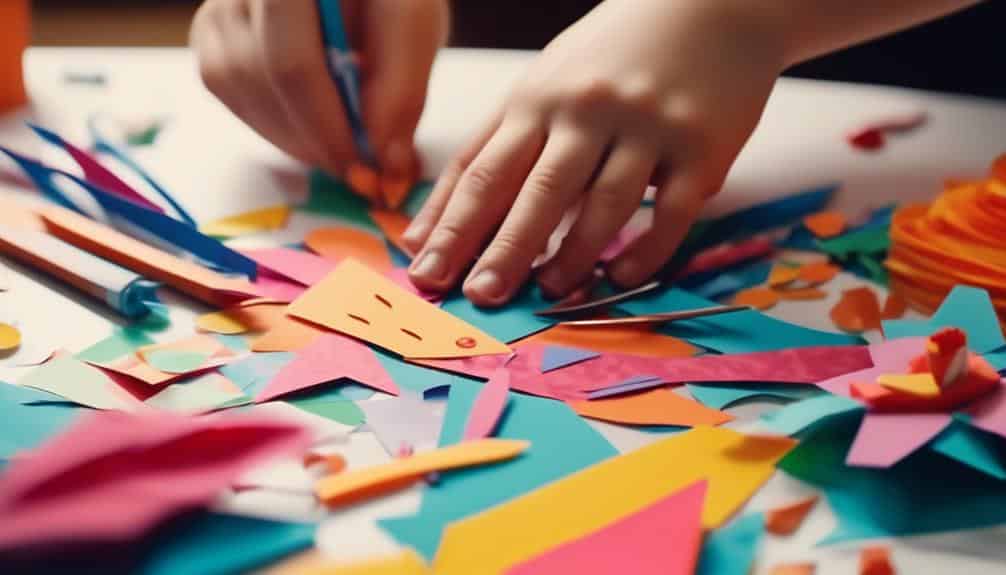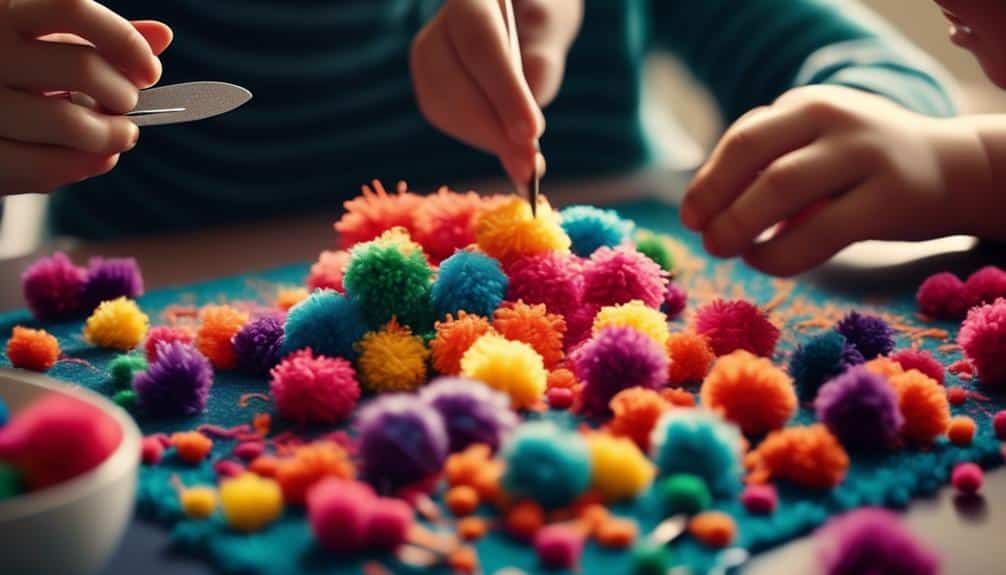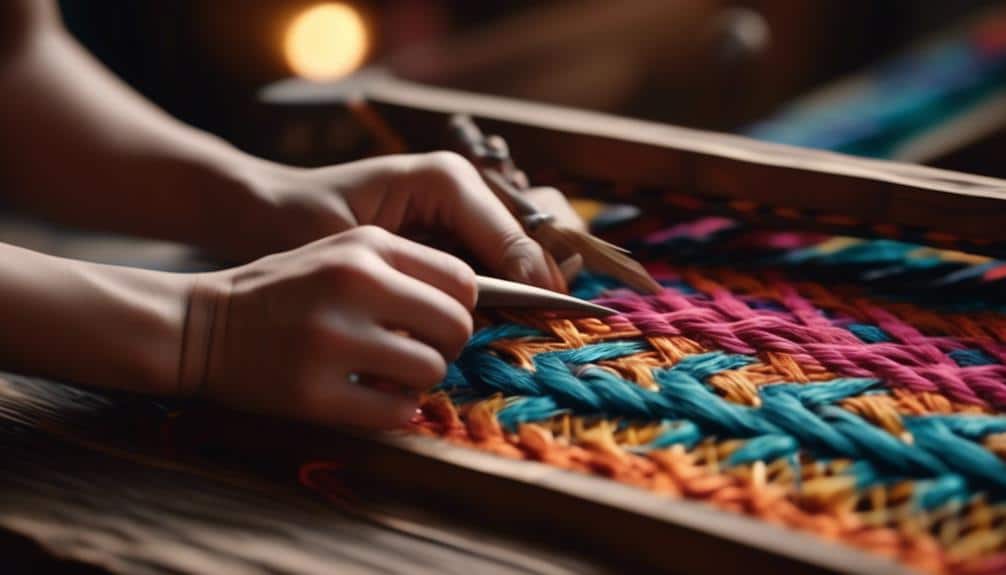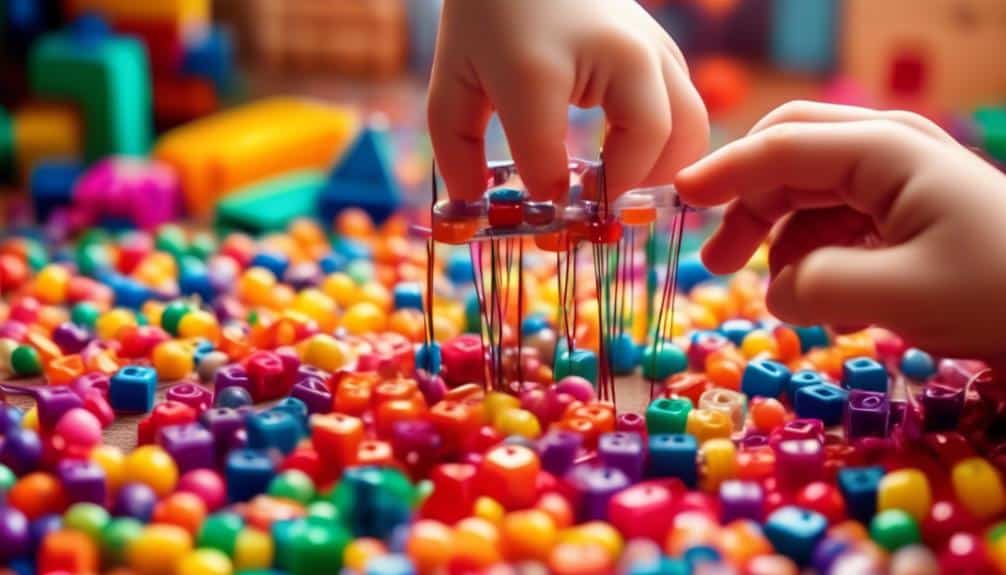Developing fine motor skills is a crucial aspect of early childhood education, providing a foundation for many essential life activities, from self-care to manipulating tools. Among the many strategies available to parents and educators, specific exercises stand out for their proven effectiveness in strengthening children’s hand-eye coordination, agility, and spatial awareness. The eight best fine motor skill exercises, such as Playdough Sculpting, Bead Threading, and Scissor Crafting, are grounded in pedagogical research and crafted to engage children enjoyably. As we explore these activities, each offering a unique blend of challenge and amusement, it becomes evident that they encapsulate more than play.
They are a subtle alchemy of skill-building, creativity, and cognitive development – a blend that beckons further exploration into how they can be seamlessly integrated into a child’s daily routine.
Key Takeaways
- Fine motor skill exercises such as playdough sculpting, bead threading, scissor crafting, puzzle assembling, tweezer transferring, button sorting, lace weaving, and sticker artwork offer children a wide range of benefits.
- These exercises enhance fine motor skills, develop hand and finger strength, improve hand-eye coordination, and provide sensory stimulation.
- Fine motor skill exercises can be adapted for different needs and promote precision, hand-eye coordination, and finger dexterity.
- Engaging in these exercises instills a sense of accomplishment, fosters confidence and independence, and lays a foundation for success in school and beyond.
Playdough Sculpting
Playdough sculpting is a hands-on activity that unleashes children’s creativity and systematically enhances their fine motor skills through various tactile experiences. When children engage in this form of sensory play, they are compelled to use their small muscles in enjoyable and educational ways. As they squeeze, stretch, pinch, and roll the malleable material, they inadvertently develop fine motor control and hand and finger strength, which are crucial for writing, scissors, and clothing fasteners.
Furthermore, sculpting with playdough encourages the development of a child’s pincer grasp, an essential skill that involves pinching with the thumb and forefinger. This skill is foundational for holding a pencil correctly. Additionally, the focused attention required to create shapes and objects bolsters hand-eye coordination and finger isolation, enabling children to perform more precise movements.
Beyond the functional benefits, playdough sculpting provides sensory stimulation and calming and benefits children who need additional sensory input. It’s a therapeutic and inclusive activity that can be adapted to meet diverse needs, including making sensory-friendly slime for those who prefer a different texture. Thus, playdough sculpting is an indispensable tool in fostering children’s developmental milestones with empathy and understanding.
Bead Threading
Bead threading is an activity that captivates children’s attention through its colorful appeal and enhances their fine motor skills and cognitive development. Children learn to adapt their grip and control by introducing bead size variation, progressing from more accessible large beads to more complex smaller ones. Incorporating the challenge of pattern creation into bead threading exercises further stimulates a child’s problem-solving abilities and encourages patience and focus.
Bead Size Variation
Gradually introducing children to bead threading with various bead sizes offers an effective method to refine their fine motor skills and talent. As development facilitators, we understand the importance of tailoring fine motor skills activities to each child’s pace and abilities.
- By starting with larger beads:
- Children gain confidence as they successfully thread beads onto laces.
- It fosters the development of muscle memory and bilateral integration.
- Progressing to smaller beads:
- Encourages precision and enhances hand-eye coordination with different shapes.
- Challenges children to fine-tune their finger dexterity and strengthen hand muscles.
This approach promotes steady skill advancement and instills a sense of accomplishment as children master the coordination of threading laces through progressively challenging beads.
Pattern Creation Challenge
Building upon the foundation set by varying bead sizes, the Pattern Creation Challenge further refines children’s fine motor skills by threading beads into specific designs. This activity develops fine motor precision and encourages the growth of hand-eye coordination. Children can explore their creativity by engaging in this acceptable motor activity while strengthening problem-solving skills as they design and execute intricate patterns.
Starting with larger beads on pipe cleaners can facilitate early success, promoting confidence as kids gradually progress to smaller beads and more complex patterns. This challenge fosters patience and concentration, essential for developing meticulous hand movements and bilateral integration and enhancing muscle memory through repetitive practice.
Scissor Crafting

Scissor crafting is a dynamic way to enhance a child’s fine motor skills, but it’s crucial to prioritize safety and suitability for their age and skill level. Starting with age-appropriate scissors and activities, children can safely explore using this tool while engaging in creative and developmental exercises. From simple paper cutting to more complex crafting projects, these activities foster talent and encourage cognitive development through careful planning and execution.
Safety First Approach
Ensuring the safety of children during scissor-crafting activities is paramount, which begins with close supervision and the use of child-friendly scissors designed for their tiny hands. Adopting a safety-first approach is crucial to protect the child while allowing them to engage in exercises that help strengthen their fine motor skills and coordination.
- Supervision and Scissor Selection
- Continuously monitor the child closely.
- Opt for scissors with blunt tips and ergonomic handles.
- Teaching and Technique
- Instruct on proper scissor handling.
- Guide them to cut along predefined lines.
Age-Appropriate Scissor Activities
Having established the importance of safety and proper technique in using scissors, we now turn our attention to various scissor-crafting activities tailored to the developmental stages of young children. These scissor activities are crucial for helping little ones develop fine motor skills and coordination required for more complex tasks. For instance, engaging in sticker activities not only aids in refining their pincer grasp but also enhances visual motor coordination as they place stickers following specific patterns.
Children work on two-handed coordination by stringing Cheerios and ripping paper for mosaic crafts; they strengthen hand muscles. Encouraging the sorting and stacking of coins further develops their pincer grasp and finger strength, while attaching clothespins and using sidewalk chalk creatively fosters their fine motor skills.
Puzzle Assembling
Assembling puzzles offers children a multifaceted learning experience, enhancing their fine motor skills and cognitive development through the careful coordination of hands and eyes. This activity is enjoyable and practical to strengthen hand and finger muscles, which is critical in early childhood development.
Puzzle assembling is considered one of the most beneficial fine motor skills toys, providing a hands-on method to:
- Develop fine motor precision:
- Encourages the pincer grasp, which is essential for writing and other daily tasks.
- Improves finger dexterity and strength as children manipulate small and sometimes intricate puzzle pieces.
- Boost cognitive abilities:
- Enhances hand-eye coordination and visual perception, allowing children to discern and fit puzzle pieces accurately.
- Promotes cognitive skills like problem-solving and spatial awareness, as children recognize shapes and colors to complete the puzzle.
Incorporating activities to develop these skills is crucial, and puzzle assembling is a highly effective exercise. It’s a resourceful way to help improve a child’s fine motor and cognitive abilities in a nurturing and stimulating setting. By engaging in this task, kids learn and gain a sense of accomplishment with each completed puzzle, fostering confidence and independence.
Tweezer Transferring

Tweezer transferring exercises, in which children use tweezers to move small items like beads or grains of rice from one location to another, are a powerful way to refine fine motor skills and enhance manual dexterity. These activities develop fine motor control and hand strength and improve hand-eye coordination and precision, crucial components of a child’s early development.
When children engage in tweezer transferring, they practice the pincer grasp—the same necessary motion for writing and self-care tasks. Through repetition, their fingers become more adept at manipulating small objects, promoting skill and precision that will serve them in various aspects of life.
Incorporating tweezer transferring into the daily routine can prove invaluable for parents and educators looking for practical activities for preschoolers. It’s a simple yet effective exercise that can be fun and engaging through colorful beads or shaped rice grains. Furthermore, these activities can be adapted to match the child’s progress, ensuring a continual challenge and the opportunity to celebrate achievements in motor skill milestones.
Empowering children with the tools to develop fine motor skills lays a foundation for success in school and beyond. Tweezer transferring is a practical and accessible exercise that nurtures these skills with each small transfer.
Button Sorting
Button sorting is a simple and engaging activity that captivates children’s attention and significantly enhances their fine motor skills and hand-eye coordination by manipulating small, varied objects. Little Hands will delight in the array of colors and shapes, while caretakers can take pride in facilitating meaningful developmental play.
By integrating button sorting into a child’s playtime, we actively help develop:
- Fine Motor Control
- Encouraging the use of the pincer grasp by picking up and placing buttons promotes dexterity.
- Threading buttons onto string or pipe cleaners strengthens hand and finger muscles.
- Hand-Eye Coordination and Precision
- Creating button art or patterns allows children to place buttons, refining their motor planning meticulously.
- Sorting buttons into compartments by color or size reinforces visual discrimination skills.
This multifaceted exercise not only aids in developing the pincer grip, which is crucial for writing and self-care tasks but also supports cognitive skills such as categorization and sequencing. Button sorting, a seemingly simple task, is a substantial stepping stone to mastering fine motor skills. It offers Little Hands a foundation of fun and learning, setting the stage for a lifetime of skillful manipulation and keen coordination.
Lace Weaving

Building on the agility and coordination cultivated through button sorting, lace weaving offers children a complementary avenue to refine their fine motor skills and muscle memory. This engaging activity prepares youngsters for the practical life skill of tying shoelaces and enhances their fine motor control. By threading laces through larger and progressively smaller beads, children can incrementally increase the challenge, encouraging continued growth in their motor development.
Lace weaving demands precision and coordination of the hands and forearms. It nurtures hand-eye coordination and finger dexterity, essential for writing and other daily tasks. As children manipulate the laces, their hand, and finger strength are bolstered, leading to a more precise grasp and improved fine motor control. This organized activity also cultivates patience and concentration, as it requires sustained attention to detail.
Sticker Artwork
Sticker Artwork, a delightful and accessible form of creative expression, empowers children to enhance their fine motor skills by meticulously placing stickers to form intricate designs and images. This activity fosters hand-eye coordination and encourages a child’s imagination and creativity.
- Engaging in Sticker Artwork allows children to:
- Explore their artistic side by choosing stickers that appeal to their interests and arranging them in unique patterns.
- Feel a sense of accomplishment as they complete a visual piece of their own making.
- Benefits to fine motor development include:
- Improving dexterity as children peel and place stickers of various sizes.
- Building precision and control in little hands is essential for writing and buttoning clothes.
Sticker Artwork is a splendid choice for caregivers and educators seeking activities that are enjoyable and instrumental in helping children develop critical skills. Selecting, positioning, and smoothing stickers onto a surface provides a tangible and satisfying experience for young ones, contributing to their growth in a fun and artistic manner.
Frequently Asked Questions
How Can I Improve My Child’s Fine Motor Skills?
To enhance your child’s fine motor skills, consider activities that involve precise hand movements, such as sorting small objects, threading beads, or manipulating playdough, as these can significantly improve dexterity and hand-eye coordination.
How Do You Train a Fine Motor for Kids?
To address concerns regarding engagement, training fine motor skills in children can be made enjoyable through creative play that incorporates tactile activities, enhancing their agility and coordination in a nurturing and supportive environment.
What Is Something That a Child Can Do to Increase Fine Motor Dexterity?
To enhance fine motor skills, a child might engage in activities that require precise hand movements, such as assembling puzzles, which improve hand-eye coordination and finger strength.
What Fine Motor Skills Should a 10-Year-Old Have?
A 10-year-old should exhibit fine motor skills that enable them to perform tasks requiring precision, such as assembling complex structures, crafting detailed artwork, and engaging in games that challenge dexterity and hand-eye coordination.
Conclusion
Motor skills activities are fun activities that children of all ages can enjoy. These activities can help improve finger strength, grip strength, pincer grip, pincer grasp, and finger isolation. They also assist in developing motor skills, motor coordination, and motor functions. These activities can be done using balls, pipe cleaners, pieces of paper, water bottles, tennis balls, chip clips, cookie cutters, egg cartons, cardboard boxes, and rubber bands. Plastic tweezers, jumbo tweezers, and squeeze balls are great tools for improving motor precision.
Engaging in motor skills activities can help children develop problem-solving skills, body awareness, and cognitive development. It can also enhance muscle strength, spatial awareness, and visual-motor coordination. These activities help children develop neural pathways that are essential for motor skills.
Childcare providers and parents can use motor skills activities to improve children’s language skills, literacy skills, and language development. It is also a great way to introduce physical activity into daily lives. These fun activities can be turned into obstacle courses to challenge motor skill development further.
These activities can be enjoyed by normal children aged 19-21 months and 22-24 months. They can use a piece of string to create pom-pom balls, fold paper into paper balls, or bounce a ball. They can also use rubber bands to make a band ball or condiment bottles to create art activities.
In conclusion, motor skills activities significantly improve children’s physical development and motor skills. It is a fun activity that can be used to enhance children’s daily living. It is also an excellent therapy for children with motor skill development issues.


Recent Comments